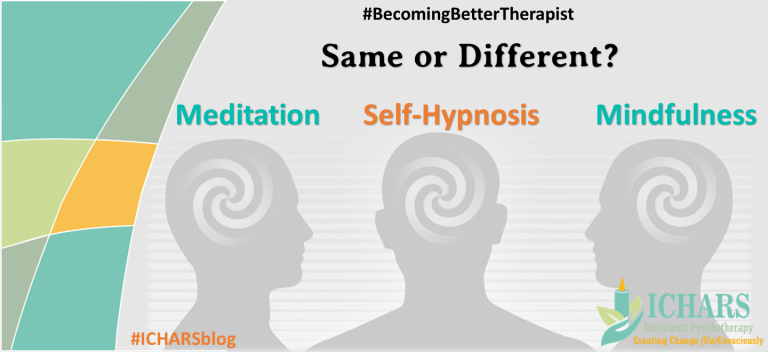Before we talk about the similarities and differences between Mindfulness, Self Hypnosis and Meditation, let us quickly look at what is self hypnosis.
You may know that all hypnosis is self hypnosis! Sometimes another person, such as a therapist, may guide you into a hypnotic state but since hypnosis only occurs if you allow it to, it is actually self-hypnosis.
And going into hypnosis is natural and easy. In fact, you do it yourself several times on any given day.
 It is as if you have drifted off into a peaceful place, and are not worried about the outside world, for a while.
It is as if you have drifted off into a peaceful place, and are not worried about the outside world, for a while.
That’s hypnosis.
And in a hypnotic state, it becomes possible to make positive, sustainable changes in your life.
Mindfulness, Self Hypnosis and Meditation
Many people wonder how mindfulness, self hypnosis and meditation are similar or different or are they different forms of the same thing?
While these practices share common elements, all three are very different based on the end objective.
 Let’s, first, take a look at a very basic form of meditation.
Let’s, first, take a look at a very basic form of meditation.
- Sit or lie comfortably in a quiet place.
- Close your eyes and focus on your breath. Breathe slowly, in through your nose and out through your mouth.
- In case you are distracted, bring your focus back on your breathing again. Continue focusing on your breath.
- Allow your body to relax and mind to become calm.
- When you’re ready to end the session, slowly open your eyes and bring your awareness back to your surroundings.
Of the various ways to induce a hypnotic state in self, focusing on the breath and relaxation are the easier ones. Now, if you look at these steps carefully, you’ll find that these steps could easily induce a person into a hypnotic state.
Another important observation you may like to make here is meditation requires fewer steps.
Hypnosis, and self hypnosis, involves 3 major phases of induction, change and waking up / exit. On the other hand, meditation is simply the first stage, the induction stage.
In other words, meditation is a goal in itself. However, self hypnosis has a definite goal. It may begin in the same way as meditation but then moves into the change phase, where the change work takes place.
In this change phase, suggestions can be made to –
- effect new behaviours and/or mental states
- change limiting beliefs
- reduce fear or anxiety
- cure phobias
- relieve stress
- manage weight loss
- improve your relationships
- manage pain
- set and achieve achievable goals
And of course, you can use hypnosis techniques just to relax. But even then, you have a goal – relaxation.
With meditation, you don’t have a goal. Meditation is a goal onto itself.
 With self-hypnosis, you can achieve instant, deep relaxation and more! You can also achieve changes in other areas of your life that you want to change or improve.
With self-hypnosis, you can achieve instant, deep relaxation and more! You can also achieve changes in other areas of your life that you want to change or improve.
And that’s why self-hypnosis is such a powerful tool.
Not only that, self-hypnosis is also the fastest, easiest and most efficient way to make positive, sustainable changes.
Self Hypnosis and Mindfulness
And what’s mindfulness?
 In simple words, mindfulness is the process of paying attention to the present. When you practice mindfulness, you are trying to experience what’s happening right now, in the present moment.
In simple words, mindfulness is the process of paying attention to the present. When you practice mindfulness, you are trying to experience what’s happening right now, in the present moment.
You’re not concerned about the past, nor the future. This is based upon the philosophy that since you can’t change the past (it’s already passed!) and the future is unknown.
You exist in the present, and it makes sense to focus your attention on the present. This mindfulness helps you achieve.
And focusing on something is also a way of inducing hypnosis. It is a state in which all your attention is focused on something particular and you seem to tune out of everything else. That makes mindfulness partly akin to hypnosis.
However, since you are focused on everything in the present, mindfulness is NOT a relaxation technique!
Relaxation is about hitting the ‘off’ switch. Mindfulness is the opposite – experiencing everything in the ‘here and now’. You can’t do that if you simply relax. The aim is to focus on whatever is going on, such as your thoughts or emotions right now.
For example, if you are frustrated with something that’s not going as well in your life. Instead of trying to ignore or suppress it, mindfulness helps you deal with it right away. It also prevents the frustration from bottling up and lead to even more frustration, or anger or stress later.
However, not everyone can resolve their problems by becoming aware of them or focusing on them. In fact, this may make it even worse for them.
So mindfulness is also NOT a change process.
Yet mindfulness exercise can be a good discovery tool.
From there, hypnosis or self-hypnosis, can be used to further identify and change what is required.
This makes hypnosis the most comprehensive way of creating positive, sustainable changes to lead your life the way you want to.
To know more about learning to use hypnosis, visit chp.ichars.com

